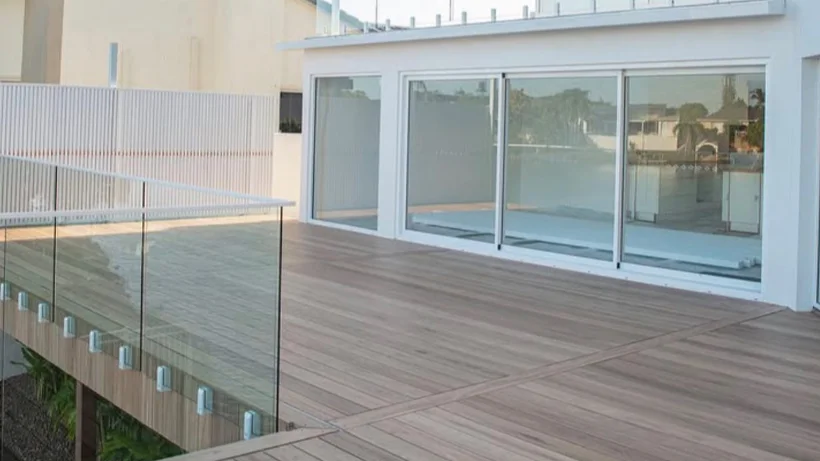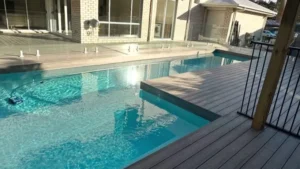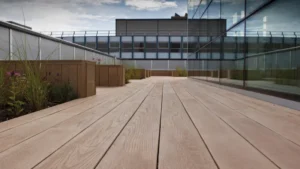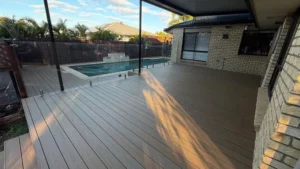
Also known as wood-plastic composite (WPC), composite decking has resonated deeply with many Australian homeowners. Unlike traditional timber decks requiring frequent cleaning, sealing, sanding, and refinishing, the composite version’s low-maintenance features provide a welcome relief from the burden of frequent upkeep, allowing homeowners to relax and bask in their outdoor living space.
Manufacturers make composite decking from wood fibres and plastic, enabling it to withstand harsh climates, fading, staining, and deterioration. Hence, this fixture provides clients with a resilient, long-lasting solution that offers a high return on investment.
Choosing the appropriate decking cannot be overstated since it can significantly compromise the visual appeal, resilience, and long-term maintenance of your outdoor area. Although WPC is more cost-efficient than conventional timber, please remember that many outdoor deckings are better than others.
If you’re considering WPC for your outdoor space but need valuable insight, we’re here to guide you. As a trusted Sydney composite decking stockist with extensive industry experience, our expertise can help you make an informed decision about capped vs uncapped composite decking, enabling you to make informed long-term buying decisions that improve your quality of life.
What Is Capped Composite Decking?
Capped composite decking is a premium outdoor fixture alternative that significantly enhances the aesthetics and functionality of your living space. As the term implies, this decking has a protective layer (“cap”) that shields its interior components from excessive moisture, ultraviolet (UV) rays, mould, and mildew.
The structural components of capped composite decking include the following:
- Core: Similar to uncapped composite decking, the capped version’s core combines wood fibres and plastic to create a durable, long-lasting, and sustainable outdoor fixture.
- Protective layer/cap: Capped composite decking has a resilient protective layer usually made of weather-resistant components, such as polyvinyl chloride (PVC) or acrylic. Manufacturers latch the cap onto the core to create a tough outer layer that can withstand heavy rain, harsh sunlight, humidity, dirt, organic matter, and insect infestation.
Capped Composite Decking Benefits
Capped composite decking offers Australian homeowners premium protection against various environmental and aesthetic challenges, including the following:
Increased resilience to harsh weather conditions
Whether you live in an area prone to harsh sunlight or heavy rainfall, capped composite decking’s premium protective layer can give you long-term peace of mind.
Manufacturers create capped composite decking to withstand moisture, UV rays, and temperature fluctuations. The cap protects the core from these environmental hazards, ensuring long-lasting quality, prolonged lifespan, and value for money, giving homeowners a sense of security and confidence in their investment.
Surface damage protection
Without a protective layer, composite decking may develop fading, staining, and scratching over time. For this reason, manufacturers equip the cap with premium UV inhibitors and colour pigmentation, ensuring the decking retains its decorative allure and withstands visible surface damage.
Low-maintenance
Inferior-quality decking succumbs to the elements and requires frequent and tedious maintenance, which many homeowners consider a deal-breaker.
Fortunately, capped composite decking doesn’t require frequent staining, sealing, and refinishing, relieving you of the burden of regular upkeep and allowing you to focus on your essential obligations.
Capped composite decking’s game-changing protective layer prevents moisture seepage, mould, mildew, stains, dirt accumulation, and long-term deterioration. You only need to clean it with soap and water twice annually to ensure it looks pristine and spotless.
What is the difference between capped and uncapped composite decking? Not only does the former protect your outdoor deck from several environmental and aesthetic challenges, but it also eliminates the need for frequent and costly repairs and replacements, providing you with financial security and peace of mind.
What Is Uncapped Composite Decking?
Uncapped composite decking offers Australian homeowners a more affordable option than its capped counterpart. It’s an excellent choice for clients who prefer the advantages of composite decking, eliminating the cost of a premium protective layer.
Manufacturers combine wood fibres and plastic to create uncapped composite decking. However, it doesn’t have the capped version’s protective layer. Hence, uncapped composite decks rely heavily on the core to withstand environmental and aesthetic challenges, such as extreme climates, temperature fluctuations, moisture, fading, staining, and scratching. Although the core can endure harsh weather, moisture, and UV rays, it may succumb to visible surface damage over time.
Uncapped Composite Decking Benefits
The advantages of uncapped composite decking include the following:
- Affordable: Without the premium protective layer, uncapped composite decking has a lower cost than its capped version. Hence, manufacturers can offer competitive prices to customers with limited budgets who seek a reliable outdoor fixture.
- Realistic timber appearance: Uncapped composite decking closely mimics authentic traditional timber decking’s visual appeal. The absence of a protective layer allows the core to expose grain patterns and wooden fibre textures, enhancing the deck’s aesthetics and appealing to Australian homeowners who prefer a conventional and natural outdoor living space.
- Easy to install: Uncapped composite decking is an ideal choice for homeowners who prioritise ease of use and efficiency. Its lack of a protective layer makes cutting and drilling easier than its capped counterpart, making it ideal for those who love a DIY project.
Although uncapped composite decking doesn’t offer premium surface protection like its capped counterpart, factors such as its lower cost, authentic timber appearance, and ease of use are worth considering.
When choosing between uncapped composite and conventional timber decking, the former offers better resistance to warping, surface deterioration, and insect infestation than the latter. Uncapped composite decks’ easy installation and long-term maintenance relieve homeowners of the burden of tedious upkeep and allow them to enjoy hassle-free outdoor living.
Best Scenarios for Capped Composite Decking
As trusted Brisbane composite decking stockists with extensive experience, we recommend choosing capped composite decks for homeowners who prioritise low-maintenance, resilience, and longevity. The premium protection they offer against fading, staining, scratches, and extreme climates can be a game-changer for your outdoor living space.
Despite capped composite decks’ higher upfront costs, their low-maintenance requirements ensure homeowners minimise long-term costs and receive a significant return on their investment. These fixtures can transform high-traffic environments, coastal surroundings, or homes requiring durable, eye-catching decking.
Please remember that many capped composite decking versions offer better quality and protection than others. Choosing a reputable contractor with extensive industry experience can help turn your decking into a wise, long-term investment.
Best Scenarios for Uncapped Composite Decking
Uncapped composited decking is an ideal choice for Australian homeowners who prefer the advantages of these fixtures without the cost of a premium protective layer. It closely mimics the visual appeal of conventional timber decking, making it an attractive and affordable option for those on a budget.
Although uncapped composite decking has a shorter lifespan and requires more upkeep than the capped version, it can be a functional choice for mild climates and clients amenable to regular maintenance. To sum things up, uncapped composite decks are the better alternative for budget-conscious homeowners who prioritise conventional visual appeal over long-term durability.
Our Most Popular Pioneer Decking Styles
Pioneer decking sets a new standard in composite decking with its unmatched realism. Be sure to view our most popular Pioneer decking styles:
- 5.45m Spotted Gum Eva-Last Pioneer Composite Decking
- 5.45m Blackbutt Eva-Last Pioneer Composite Decking
Conclusion
Deciding between capped vs uncapped decking doesn’t have to be daunting. Each outdoor fixture alternative has unique advantages that resonate with Australian homeowners with different tastes and preferences.
For some homeowners, the capped composite decking’s premium protective layer’s long-term durability and low-maintenance requirements appeal to them. On the other hand, some clients prefer the affordability, unique timber appearance, and easy manipulation of the uncapped version. Regardless of your preferred fixture, consider installing one that aligns with your lifestyle and long-term objectives.
Ezy Decking is Australia’s trusted provider of premium decking solutions that enhance the functionality and elegance of outdoor living spaces. Contact us today to schedule an appointment, arrange an on-site inspection, receive a personalised, upfront quotation, and discover cost-effective decking services that deliver guaranteed results.
Related Articles

Composite Decking vs PVC: Which Is Right for You?
When it comes to installing a spacious deck in your outdoor living area, the array of designs and materials available…

Enhancing Commercial Environments With Composite Decking
Commercial composite decking has revolutionised how Australian businesses and trade activities operate. These premium outdoor fixtures offer clients durability, aesthetics,…

Top 6 Must-Know Facts About Composite Decking
Also known as composite decking, wood-plastic composites (WPC) have gained popularity as a flooring, cladding, or decking material due to…





